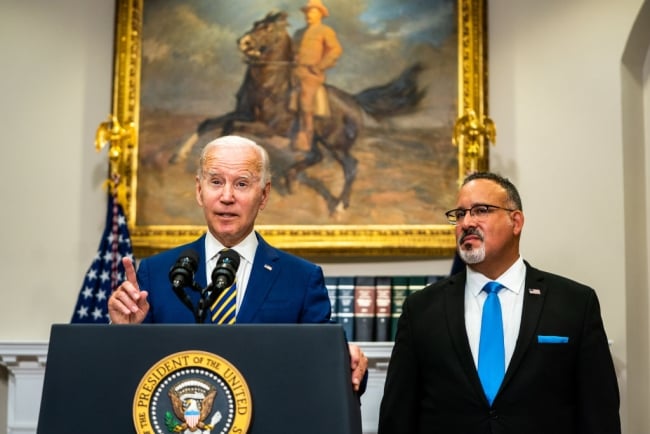You have /5 articles left.
Sign up for a free account or log in.

The Biden administration’s regulations changing how colleges are held accountable and adding new requirements for institutions to access federal financial aid are now in place, though legal challenges loom.
A host of new federal regulations took effect Monday, and Education Department officials say the new rules make up part of “the most effective system ever to oversee predatory and low-quality institutions of postsecondary education.”
Several of those regulations and other changes that became effective July 1 are facing legal challenges, and some have been blocked. Whether they remain in place may depend on how federal courts interpret Friday’s Supreme Court ruling that limits the regulatory power of federal agencies—and on the outcome of the presidential election in November.
The wide-ranging set of regulations boosts oversight of postsecondary programs, flags colleges at risk of closure and puts new requirements in place for colleges to access federal financial aid. The Education Department also is limiting when a university can withhold a student’s transcript and requiring institutions to provide adequate career services and more information on financial aid offers to students, including details of the actual cost of the education being provided. Several new benefits for student loan borrowers enrolled in a new income-driven repayment plan also took effect Monday.
Elsewhere in the federal government, the Biden administration’s rule expanding overtime eligibility to lower-paid workers kicked in this week. The rule could mean a pay boost for thousands of employees on college campuses, though a federal judge has blocked the change for state workers in Texas.
Taken together, this round of new rules and regulations involves significant changes in institutional accountability, consumer protections for students and employee pay. Below is a breakdown of some of the key changes and the legal challenges that could thwart them.
Expanding Overtime Eligibility
Employees who work in an executive, administrative or professional capacity and make less than $43,888 are now eligible for overtime pay. Previously, employees who earned more than $35,568 a year were exempt from overtime. The overtime threshold is set to increase again, to $58,656, starting Jan. 1, 2025.
This first increase is expected to extend overtime benefits to about one million workers across all sectors of the economy, the White House said in a statement Monday. Once the second increase kicks in, another three million will be eligible for overtime. The salary threshold will then increase every three years starting in 2027.
On college campuses, nearly 11,000 employees across 646 institutions will be affected by the July 1 increase, according to an analysis by College and University Professional Association for Human Resources (CUPA-HR). The Jan. 1 increase will affect many more—nearly 59,000 employees across 882 institutions.
To comply with the rule, colleges and universities can either reclassify salaried employees to hourly and pay them overtime or pay employees more so they can be exempt from overtime.
Workers likely to see a pay raise or receive overtime pay are admissions officers, counselors and advisers, student affairs professionals, and administrative staff. Coaches, faculty members and nonfaculty workers focused primarily on teaching aren’t affected because of a teaching exemption in federal labor law.
Colleges and universities have warned that raising the overtime threshold could mean tuition increases or layoffs, along with other disruptions. CUPA-HR, which opposed the overtime change, says that the new salary thresholds will have an especially negative impact on the bottom lines of institutions with fewer resources. The Jan. 1 increase, further, will cause a “widespread negative impact to higher ed institutions,” CUPA says.
The state of Texas, along with a coalition of groups led by the Plano Chamber of Commerce, have sued the Department of Labor over the rule, arguing in part that setting the new salary thresholds exceeded the agency’s authority. On Friday, a federal district judge put the rule on hold for state employees in Texas.
Bolstering Oversight of Career Education Programs
For-profit colleges and nondegree programs in any sector will now need to show that their graduates are earning enough to afford their annual debt payments—and that they are making more than an adult in their state who didn’t go to college.
Those who fail either of those tests in two consecutive years could lose access to federal financial aid under the Biden administration’s new, stricter gainful-employment rule—a measure that backers say provides critical guardrails to protect students. The department is planning to begin reporting data on students’ debt and earnings and penalize failing programs in July 2026.
This marks the third time in the last 14 years that the federal government has sought to hold certain for-profit and nondegree programs accountable for their students’ outcomes. The 2011 iteration was struck down by the courts and the 2014 version was upheld, though the Trump administration later rescinded it.
All colleges and universities have until Oct. 1 to report new program-level information, including the total cost of attendance and the amount of private education loans disbursed to students, under regulations for a new financial value transparency framework that’s part of the gainful-employment rule. The data was initially due July 31, but the department pushed the deadline back a few months following delays and issues with the new Free Application for Federal Student Aid.
Graduate degree and certificate programs are subject to new requirements under the financial value transparency provisions. Students who enroll in a graduate program that leaves completers with debt they can’t afford will have to sign a disclosure notice starting in 2026. Education Department officials have said that about 400 graduate programs enrolling roughly 120,000 students would be subject to the disclosure requirement.
The American Association of Cosmetology Schools sued the Education Department over gainful employment in December, arguing that the rule would jeopardize the “very existence” of its schools. That lawsuit is ongoing.
In a separate lawsuit, the Ogle School, a Texas-based beauty school, sought a preliminary injunction to block the entire rule from taking effect. A Texas district judge denied that request last month.
Banning Transcript Holds
Another new rule takes aim at a controversial practice at colleges and universities: withholding a student’s transcript when they owe money to the institution. Without a transcript, students who transfer to another institution can’t prove they’ve earned college credits and have to start over. Ending the practice nationally could help about six million students access their college credits.
Federal regulations no longer allow colleges that receive federal financial aid to withhold transcripts for course credits paid for with federal money. Some experts have said that could amount to a national ban on the practice. That’s because it will be difficult for institutions to determine which credits were paid for with federal money and then provide transcripts for only those courses.
A recent survey from the American Association of Collegiate Registrars and Admissions Officers found that most respondents planned to eliminate transcript holds.
The ban on withholding transcripts is among several new conditions added to the program-participation agreements that colleges must sign with the government in order to access federal financial aid.
New Benefits for Borrowers
The final pieces of the Biden administration’s new income-driven repayment program, known as Saving on a Valuable Education (SAVE), are now in place after a federal appeals court blocked a lower court’s injunction Monday.
SAVE is the culmination of President Biden’s efforts to forgive student loans and fix previous debt-relief programs that didn’t work as intended. Experts say SAVE could overhaul the way students pay for college and be more far-reaching than any of the other student loan policy changes.
The legal back-and-forth had created uncertainty for borrowers and prompted the Education Department to essentially pause loan payments for three million people.
The appeals court decision restored several benefits for borrowers that had been slated to begin Monday before a district judge enjoined them last week. (In a separate lawsuit, a federal judge in Missouri blocked the Biden administration from forgiving any more loans via the new repayment program. That injunction is still in place.)
Undergraduate borrowers int he program will now see their monthly student loan payments cut in half, and the department can automatically enroll borrowers in default into SAVE, among other changes. Some provisions of SAVE have been in effect since last summer.
The income-driven repayment plan, more generous than its predecessors, sets monthly payments to as low as $0 for low-income individuals and offers forgiveness after 10 years of repayment for those who initially borrowed $12,000 or less, among other terms. Nearly eight million borrowers have signed up for SAVE, about half of whom now have no monthly payments.








